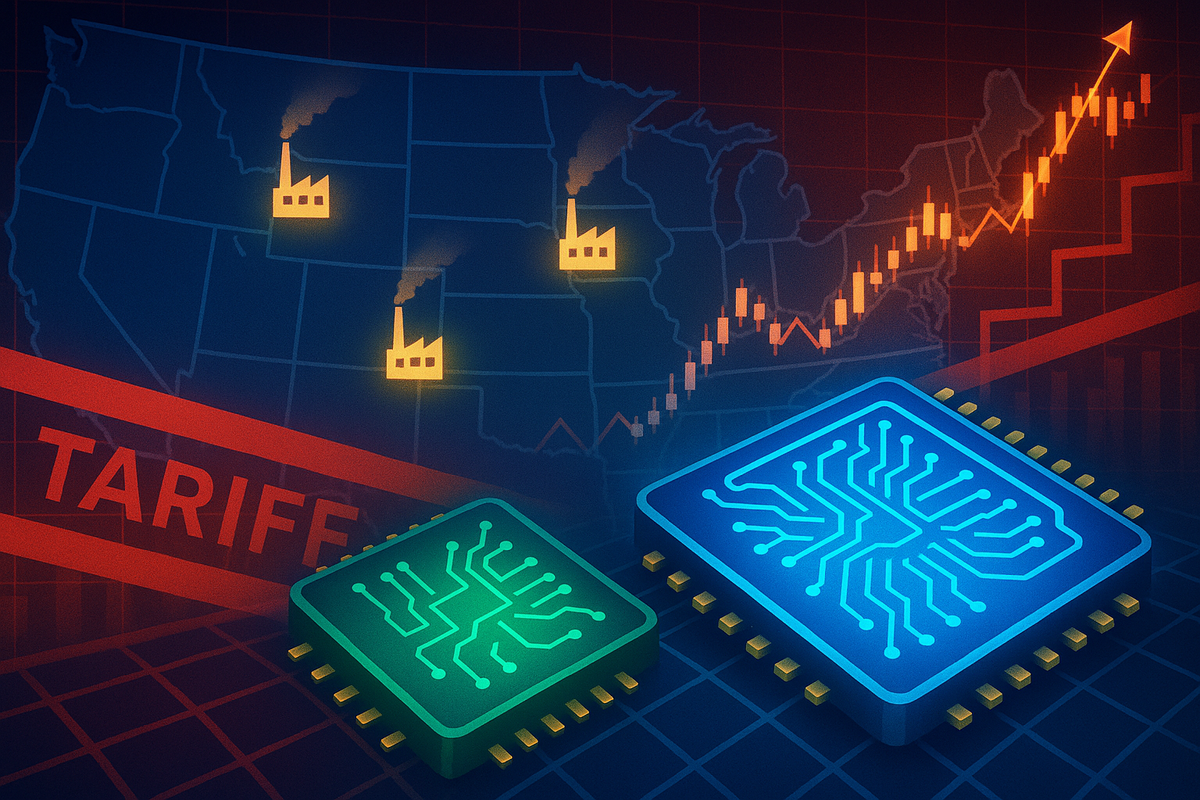Financial News
Trump's Tariff Gambit: Chip Exemptions Spark Tech Rally Amid Broader Trade Tensions

President Donald Trump's administration has unveiled a sweeping new "reciprocal" tariff policy, sending ripples across global markets. A cornerstone of this new framework is a formidable 100% tariff on imported computer chips and semiconductors. However, a crucial caveat—exemptions for chips manufactured by companies with U.S. production facilities—has significantly altered the immediate market landscape, particularly for the tech sector. This nuanced approach has led to an initial positive response in some major technology and chip stocks, even as broader concerns about escalating trade wars persist.
A Bold Stroke: Tariffs on Chips and the Strategic Exemption
The announcement of a 100% tariff on foreign computer chips and semiconductors marks a significant escalation in the Trump administration's trade policy, aimed squarely at incentivizing domestic manufacturing. This declaration, made during a high-profile meeting with Apple (NASDAQ: AAPL) CEO Tim Cook, included a pivotal detail: companies that are "building in the United States of America" or have committed to do so would be exempt from this hefty import tax. This strategic carve-out immediately shifted market sentiment, transforming what could have been a devastating blow to the tech industry into a potential boon for companies with a U.S. manufacturing footprint.
The timeline leading up to this moment has been characterized by a consistent push from the Trump administration for reshoring manufacturing, particularly in critical sectors like technology. While previous administrations often relied on financial incentives to boost domestic chip production, this new policy leverages the threat of dramatically higher import costs to compel companies to establish factories domestically. The immediate market reaction underscored the perceived benefit of these exemptions. For instance, Apple's stock price saw a notable 5% gain in regular trading sessions on the day of the announcement, followed by an additional 3% rise in extended trading. This robust positive response from Wall Street suggests that the market believes the deal brokered between Cook and Trump could effectively insulate products like iPhones, which are largely manufactured in China and India, from the tariffs, thereby potentially alleviating pressure on companies to raise consumer prices. Beyond the specific chip tariffs, this move is part of a broader set of "reciprocal tariffs" that have gone into effect, imposing higher duties on exports from over 60 countries and the European Union, with rates ranging from 10% to as high as 50% for some nations.
Winners and Losers in the New Tariff Landscape
The targeted nature of the chip tariff exemptions creates a clear delineation of potential winners and losers within the technology and semiconductor industries. Companies with substantial existing or planned manufacturing operations in the United States stand to gain significantly, while those heavily reliant on foreign production without a domestic alternative could face considerable headwinds.
Among the most prominent beneficiaries are major global chipmakers that have already committed to or are in the process of establishing significant manufacturing facilities in the U.S. Taiwan Semiconductor Manufacturing Company (NYSE: TSM), the world's largest contract chipmaker, is a prime example, with its ongoing multi-billion dollar fab construction in Arizona. Similarly, Samsung Electronics (KRX: 005930) and SK Hynix (KRX: 000660), both with substantial U.S. investments, are expected to be exempt. Nvidia (NASDAQ: NVDA), while primarily a fabless designer, could also benefit indirectly if its manufacturing partners are incentivized to expand U.S. production, ensuring a stable and tariff-free supply chain for its cutting-edge GPUs. These companies could see increased demand for their U.S.-made chips as other tech firms seek to avoid the 100% tariff. Furthermore, companies like Apple (NASDAQ: AAPL), which have significant product assembly in Asia but rely on a global supply chain for components, could benefit if their key chip suppliers are among those with U.S. production exemptions, potentially reducing the cost burden on their final products.
Conversely, companies that lack a significant U.S. manufacturing presence for their chip supply or those heavily dependent on imported chips from regions without reciprocal agreements or exemptions could face severe challenges. Smaller chip designers or electronics manufacturers that cannot easily pivot their supply chains to U.S.-based production might see their costs skyrocket, potentially eroding profit margins or forcing them to pass on increased costs to consumers. This could put them at a competitive disadvantage against larger players with established U.S. operations.
Industry Impact and Broader Implications
The introduction of these tariffs, particularly the nuanced approach to chip imports, represents a significant shift in global trade dynamics and has profound implications for the technology industry and beyond. This event fits squarely into a broader trend of increasing economic nationalism and a push for supply chain resilience, especially in critical technological components. The COVID-19 pandemic and subsequent supply chain disruptions highlighted the vulnerabilities of relying heavily on single-source or geographically concentrated manufacturing, particularly in Asia. This tariff policy, while aggressive, can be seen as an accelerated attempt to de-risk and diversify these crucial supply chains by compelling domestic investment.
The potential ripple effects on competitors and partners are substantial. Companies that have historically relied on a globalized, cost-optimized supply chain will now be forced to re-evaluate their strategies. This could lead to a surge in foreign direct investment into the U.S. as companies scramble to establish or expand domestic production to qualify for exemptions. For partners, particularly those in countries now facing higher tariffs, it could mean a re-evaluation of trade agreements and a push for their own reciprocal policies. Regulatory and policy implications are also significant; this move could spur other nations to implement similar "reciprocal" tariffs, potentially leading to a fragmented global trade environment. Historically, such protectionist measures have often led to trade wars, increased consumer prices, and slower economic growth. Comparisons can be drawn to the Smoot-Hawley Tariff Act of 1930, which is widely considered to have exacerbated the Great Depression by stifling international trade. While the current situation is different due to the targeted exemptions, the underlying principle of using tariffs as a tool for industrial policy carries inherent risks.
What Comes Next: Navigating a New Trade Reality
The immediate future will likely see a flurry of activity as companies assess their supply chains and strategic options in response to the new tariff regime. In the short term, we can expect to see accelerated announcements of new U.S. manufacturing facilities or expansions from major tech and chip companies eager to secure tariff exemptions. This could lead to a boom in construction and job creation in specific regions of the U.S. that are attractive for semiconductor manufacturing. However, the long-term possibilities are more complex. While domestic production offers supply chain security, it often comes at a higher cost than overseas manufacturing, which could eventually translate to higher prices for consumers or reduced profit margins for companies.
Potential strategic pivots or adaptations required will include a comprehensive re-evaluation of global manufacturing footprints, increased investment in automation to offset higher U.S. labor costs, and potentially new partnerships with U.S.-based suppliers. Companies that are nimble and can quickly adapt their supply chains will be best positioned to navigate this new environment. Market opportunities may emerge for U.S.-based equipment manufacturers, raw material suppliers, and logistics companies that can support the burgeoning domestic chip industry. Conversely, challenges will include managing the increased costs of production, potential retaliatory tariffs from other nations, and the risk of oversupply if too many companies rush to build U.S. fabs without sufficient long-term demand. Potential scenarios range from a successful re-industrialization of the U.S. semiconductor sector, leading to greater national security and economic resilience, to a more pessimistic outcome where tariffs lead to higher inflation, reduced global trade, and a slowdown in technological innovation due to increased costs.
Conclusion: A Calculated Risk with Far-Reaching Consequences
President Trump's new tariff policy, particularly the 100% tariff on computer chips with its strategic U.S. production exemptions, represents a calculated risk designed to reshape global supply chains and bolster domestic manufacturing. The immediate market reaction, characterized by an initial positive surge in some tech and chip stocks, underscores the perceived benefit of these exemptions for companies with a U.S. footprint. This policy is a clear signal of a continued push towards economic nationalism and supply chain resilience, particularly in critical technological sectors.
Moving forward, the market will closely watch several key indicators. Investors should monitor announcements of new U.S. manufacturing investments, the actual impact on corporate earnings reports, and any retaliatory measures from other countries. The long-term success of this policy hinges on whether the benefits of domestic production—such as supply chain security and job creation—outweigh the potential drawbacks of higher costs and reduced global trade. While the exemptions have softened the immediate blow for some tech giants, the broader implications for global trade, consumer prices, and international relations remain significant. The coming months will be crucial in determining whether this bold tariff gambit leads to a revitalized U.S. manufacturing base or contributes to a more fragmented and costly global economy.
More News
View More





Quotes delayed at least 20 minutes.
By accessing this page, you agree to the following
Privacy Policy and Terms Of Service.



